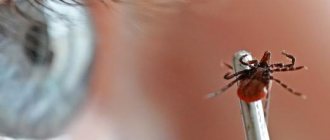Theories and hypotheses of the appearance of ticks in Russia
It is believed that ticks have always lived in Russia.
They have changed in the process of evolution, but the family of ixodid ticks flourished thousands of years ago, and today they feel great. It is known that in Siberian and Far Eastern villages people have suffered from ectoparasites for a long time, but the disease has not been associated with bites. The temperature of those who fell ill rose to 40 °C, and soon paralysis began, which in most cases ended in the death of the patient.
Those who survived either remained paralyzed or became neurologically impaired. It was believed that this was some kind of strange variety of local “Siberian fever.” Over the long history, many myths have formed around the disease, including completely crazy ones: for example, it was believed that encephalitis is a biological weapon invented by the Japanese. Scientists, however, even then put forward the theory that the disease was of natural origin and was transmitted by ticks.
The situation moved from a dead point only in 1937–1938, and then as a result of tragedy - due to mass illnesses of soldiers in the Far East. Finally, full-scale studies were launched that confirmed that ticks spread the encephalitis virus.
In May 1937, a group of scientists, headed by Professor L.A. Zilbert, went to the Far East to dot the i’s. The scientific approach, as always happens, made it possible to answer many questions. Scientists have found that encephalitis does not spread only in the summer, is not spread by airborne droplets, and that mosquitoes do not transmit encephalitis. They were also able to confirm the origin of the disease with numbers and laboratory tests, gave an accurate clinical description of the disease and the official name - tick-borne encephalitis.
Arguments in favor of the theory of the origin of encephalitis in the Far East
These conclusions are mainly based on the results obtained by Zilber's expedition.
- In the East, cases of encephalitis infection occurred already in the 20-30s, and a severe form of this disease in Western Europe was recorded in the Czech Republic only in 1948 (then the disease was called “Central European encephalitis,” although all the signs of tick-borne encephalitis were evident).
- The natural distribution zones of ixodid ticks are all forest and forest-steppe zones, from Western Europe to the Far East, plus Mongolia, China and Japan. But the first cases of diseases, which later became numerous, appeared precisely in the Far East.
- The large number of cases of disease in the Far East is explained by the fact that in the 30s there was active economic development of this region, plus at the same time there were military formations in the taiga. Carrying out economic work and the presence of troops directly in the taiga led to an increase in cases of encephalitis infection.
These ideas are still considered the most reliable.
Habitats
Ticks belong to the class of arachnids, are small in size (from 2 to 5 mm) and live almost all over the world. There are about 700 species in total.
Most ticks prefer to settle in deciduous forests, in lowlands with high humidity, and in wetlands. The main condition is tall and thick grass. They can live on low trees and bushes. For the most part, ticks feed on the blood of warm-blooded animals.
Some species coexist with humans. For example, saprophytes, that is, dust mites. They feed on dead skin particles. There are also mites that live directly on the body - demodexes. They live in the upper layer of the epidermis and near the hair follicles. Subcutaneous mites are so small that they are impossible to see with the naked eye.
Fighting ticks in the garden
You can increasingly hear that ticks have appeared on plots and gardens.
If ticks are a problem in our garden, then let's not create places suitable for them to live. We do not plant bushes too densely, we do not create damp and shady places, regularly, systematically and low. Before each visit to the garden, and especially before such work as pruning bushes, weeding and mowing grass, we apply tick repellent preparations to the skin.
In case of numerous ticks, spraying can be used
. However, we should remember that spraying the entire area may not be to our benefit. Especially if we grow vegetables or fruit trees and shrubs. You should not abuse chemicals, except for mites, we can also destroy those that pollinate flowers or feed on pests of plants.
If it is necessary to spray against ticks in the garden, we choose a proven and safe method to use. An example of such a drug is Aspermet 200EC
.
Suitable for spraying the garden as well as indoors, e.g. gazebos or garden houses. You can stay in the treated areas as soon as the fog settles after spraying. In addition, the drug allows you to get rid of mosquitoes. This solution is effective, safe and comprehensive.
All precautions significantly reduce the likelihood of tick bites in the garden, but we can never be 100% sure that ticks will not be interested in us. Therefore, upon returning home, you need to carefully examine the surface of the body.
Ticks, before they gain a foothold in human skin, look for a suitable place to feed. In children, they are most often located on the head, usually at the border of the hair and behind the ears. In adults - in places where the skin is tender (for example, under the knees, in the groin, on the stomach). It's good to take a shower. This will wash away small tick nymphs, which are difficult to detect with the naked eye.
Are there ticks in cities?
Within the city, ticks can be found in parks and near water bodies. In general, any area overgrown with a large amount of grass can be inhabited by ticks. Every year, special services treat recreation areas in the city with anti-tick drugs, but it is not always possible to completely destroy arthropods, so it is very important to take precautions when visiting parks. In small towns and urban-type settlements, such treatment may not be carried out at all - the limited budget simply does not allow carrying out measures to combat parasites. Dachas and any areas adjacent to the forest remain at risk. It is believed that encephalitis ticks are rare in large cities, but it is not worth the risk - always take precautions and be attentive.
Tick habitat
Russia occupies a leading position in the number of citizens who suffered from tick bites. Every spring and summer this problem becomes more pressing than ever. The encephalitis virus can be transmitted by:
- birds;
- animals;
- others are warm-blooded.
In the process of becoming saturated with the blood of an infected subject, ticks also become carriers of encephalitis and can infect people with it. You can become a victim of blood-sucking insects almost everywhere - in the park, at the dacha, in the forest, on a walk, etc.
Over the years, ticks have learned to adapt well to changes in the external environment and can survive even at low temperatures. The most common carriers of tick-borne encephalitis are European and taiga forest ticks. They prefer areas with dense vegetation cover, areas where grass and shrubs grow. Ticks are not found on asphalt, gravel, or trampled paths, but they can wait for you in the grass along these paths.
It should also be noted that insects live in almost any type of forest (birch, spruce, mixed, etc.). All this has contributed to the fact that on the territory of our country, insects live in almost all regions from Siberia to semi-deserts. The most common cases of tick-borne encephalitis were recorded in the following regions:
- Moscow region;
- Caucasus;
- Altai Republic;
- Volgograd;
- Kemerovo region;
- Kirov region;
- Siberia;
- Ural;
- Far East;
- Central regions of Russia and Northwestern district.
Warm and humid weather is ideal conditions for ticks to spread. The safest regions of the Russian Federation in this regard are:
- Magadan;
- Murmansk;
- Kamchatka;
- Nenets Autonomous Okrug.
| Region of Russia: | Annual incidence rate per 100 thousand population |
| Leningrad and Arkhangelsk regions | Up to 4 people |
| Tver region and Khabarovsk region | About 4-10 people |
| Khanty-Mansiysk, Tyumen, Irkutsk and Omsk regions | About 10-20 people |
| Chita, Sverdlovsk and Ufa regions | From 20 to 40 people |
| Altai and Krasnoyarsk Territories | Over 40 people |
Protection measures
The main prevention is vaccination against encephalitis. It will not save you from tick suction, but will reduce the likelihood of developing serious complications. In the warm season - the period of greatest activity of ectoparasites occurs in May and June - and when the temperature drops in early autumn, ticks are especially active. During these periods you need to be doubly careful.
Choose the right clothes
It should be as covered as possible: trousers, shirts and sweaters with a high collar to protect the neck. Pants should be tucked into socks and sweaters should be tucked into trousers. The fabric should be dense and light-colored - this way the tick will not penetrate the fabric, and you will have a better chance of noticing an arthropod crawling on your clothes in time.
There is even a special anti-encephalitis suit, which is equipped with drawstrings and reliably protects against ticks. If you regularly visit the forest, then spare no expense and be sure to get this equipment.
Use chemical protection
Popular brands are already on everyone’s lips, let’s not repeat ourselves. Let's give a little theory.
Repellents are needed to repel parasites. While acaricides paralyze and kill ticks, therefore they are considered more reliable protection. There are also combination products that combine the properties of both categories.
Repellents can be applied to both clothing and skin, but acaricides can only be applied to clothing. Protective agents should be applied to clothing in ring strips. Pay special attention to the sleeves, collar area, waist, ankles, knees and hips. It is important to remember that the protective layer will have to be renewed from time to time (the frequency depends on the type of drug).
Regular inspection
While walking, you need to examine yourself at least once every quarter of an hour. And after getting out of the potentially dangerous zone, you need to take off your outer clothing and shake it well. Look and feel yourself, paying special attention to exposed areas of your body.
There are not many protective measures, but they are simple, and their strict adherence significantly reduces the risk of infection. Well, in case they didn’t help and the tick was still able to attach itself, keep the Tick Card . With its help you can easily remove the parasite.
Delayed death: Tick season has begun in Russia
The first half of April is the time when ticks begin to appear in Russian regions. According to Rospotrebnadzor, no infections with dangerous diseases have been recorded this year, but there have already been cases of bites. In addition, some of the diseases carried by parasites can wait months before manifesting themselves in full severity.
To combat bloodsuckers, the authorities plan to carry out acaricidal treatment of 350 thousand hectares and vaccinate three million citizens. 800 thousand people have already been vaccinated against encephalitis and are now insured against the worst consequences of encountering ticks. However, this does not mean that they are protected from all the troubles that an encounter with parasites may entail.
Scale of threat
Many regions have not yet had time to wait for full warmth. The grass by no means grew to its full height, but only began to emerge from the ground. However, statistics are a stubborn thing: over the past year in April and May, 129 thousand people were bitten by ticks, including 36 thousand children. 23 people eventually became infected with encephalitis, and another 250 with tick-borne ixodid borreliosis. The largest number of victims occurred in the Kemerovo, Irkutsk, Vologda, Sverdlovsk regions, as well as in the outskirts of St. Petersburg.
In general, ticks are active from April to October; in particularly warm weather, they can wake up as early as March. But the most dangerous period is from mid-April to the end of May. This is due to the fact that arthropods actively reproduce after hibernation and need a large amount of nutrients, for which they attack warm-blooded animals. The weather conditions during this month and a half - high humidity, temperature +18...+20 ° C - are also ideal for small bloodsuckers. With the onset of heat, the air becomes drier and tick activity drops sharply.
Bitten and infected: what ticks carry
Regions where you can catch encephalitis if you go out for a spring picnic stretch across the whole of Russia. These are the Far East, Siberia, the Urals, the Volga region, Tver, Yaroslavl, Kostroma, Leningrad regions. Approximately half of the country's population lives in the risk zone.
At the same time, the viruses that cause tick-borne encephalitis in the European part of the Russian Federation and beyond the Urals are very different. The European subtype is fatal in 1–2% of cases, and persistent neurological disorders occur in 10–20%. Far Eastern encephalitis is much more dangerous: its mortality rate is 20–25%.
Photo: Spok83/shutterstock.com
Symptoms of the disease also manifest themselves in different ways. The European subtype has an incubation period of four days to two weeks. At this time, the disease does not manifest itself in any way. Then the temperature rises, fever and muscle pain begin. At this stage, tick-borne encephalitis can easily be confused with influenza or ARVI. The pronounced phase lasts 2–4 days, after which the symptoms disappear. The worst consequences begin later: about a week after “recovery,” a third of those infected experience paralysis of the central nervous system and inflammation of the membranes of the brain and spinal cord. This leads to targeted death of brain tissue and degradation of the meninges. This is precisely why the consequences of tick-borne encephalitis are so severe: it often leads to complete or partial paralysis or mental disorders.
The Far Eastern virus is much more aggressive than the European one: the first phase of the disease is characterized by a high temperature (38–39 ° C), and damage to the nervous system develops 3–5 days after the appearance of the first symptoms. Most victims die 5–7 days after the onset of neurological complications.
In addition to encephalitis, ticks can “reward” people with other dangerous diseases: typhus, tularemia, babesiosis and tick-borne borreliosis (aka Lyme disease). This is due to the fact that parasites feed on the blood of a wide variety of animals - from rodents to cattle and forest predators - and as a result they transmit infections of approximately 130 species of warm-blooded animals.
Fortunately, most of the diseases mentioned are quite rare. The exception is Lyme disease: according to statistics, from 7 to 9 thousand people are infected with it every year in Russia.
Unlike tick-borne encephalitis, this disease is caused not by a virus, but by five species of bacteria of the genus Borrelia, which are a type of spirochete and are closely related to the causative agent of syphilis. Symptoms of Lyme are similar to encephalitis: fever, pain in the head and muscles, neck stiffness, general weakness. A distinctive sign of infection is the formation of a ring-shaped inflammation on the skin around the bite site. The ring gradually expands and can reach 15 centimeters in diameter. However, in 30–40% of cases it does not occur.
Photo: Olga Vasilek/shutterstock.com
Borreliosis is dangerous because the incubation period can take a couple of weeks, or it can last for several months, even a year. Naturally, in such cases it is extremely difficult to correlate the malaise with a long-term outdoor recreation. Meanwhile, borrelia settle on internal organs, affecting joints and the heart. Manifestations of the disease can vary from sleep disturbances to facial paralysis and meningitis.
Unlike encephalitis, for which there is no specific treatment, borreliosis can be quite successfully treated with antibiotics. The main problem is to make a correct and timely diagnosis.
There is protection!
Of course, with the appearance of ticks, it is not at all necessary to sit in cities forever, avoiding forests and parks. Moreover, bloodsuckers successfully roam both city squares and summer cottages.
The first and very important step to protecting yourself and your loved ones from big troubles is vaccination against encephalitis. It is especially important to do it for residents of regions where the disease circulates in natural foci.
Secondly, contrary to popular belief, ticks do not jump onto their victims from trees. They use grass and low bushes located along the paths. Having latched onto the victim, the tick begins to look for the thinnest area of skin in a secluded place. Its speed of movement is about 12 centimeters per minute. It takes the parasite from 20 to 40 minutes to find a suitable place. In addition, the structure of the paws allows the tick to move only upward.
Photo: Crevis/shutterstock.com
Therefore, when going on a hike, a picnic or a bike ride, you need to dress properly. Pants must be tucked into shoes, shirt - under the waist belt. In areas with a lot of ticks, it’s a good idea to stop and check each other every half hour. It is better to choose clothes in light colors: it is easier to notice the parasite on them.
Getting rid of it wisely
Anti-tick medications are widely popular. They come in two types: repellents (repellents) and tick-killers (acarid substances). The problem is that repellents erode and lose their properties after just a few hours. And acaridosis compounds are not a panacea: they take time to kill the parasite, and ticks, sensing the proximity of blood vessels, manage to attach themselves to them before the chemical protection does its job.
So chemistry is truly effective only in combination with the right clothing.
What should you not do under any circumstances? Squeeze a tick that has managed to attach itself, smear it with oil or Vaseline and leave it in the expectation that it will “become unable to breathe” and it will “come off on its own.”
The main reservoir of infection is located in the tick's salivary glands. The longer the proboscis is in the skin, the higher the person's risk of infection. Quick tick removal significantly reduces the chance of infection. Therefore, experts still advise not to wait an extra hour to the hospital, stomping there with an attached parasite, but to have a strong thread with you on your hike. It needs to be wrapped around the tick, as close to the skin as possible, and carefully pulled out.
Under no circumstances should the tick be thrown away! It must be preserved and promptly taken to the laboratory, ideally to the center of hygiene and epidemiology. It is tens of times easier to detect infection in the saliva of a bloodsucker than in the human body. So submitting a tick for research can play a key role in making the correct diagnosis and prescribing treatment.











